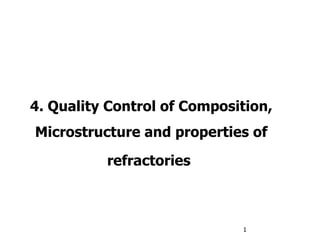The technological properties of refractory
•Als PPT, PDF herunterladen•
18 gefällt mir•8,280 views
Melden
Teilen
Melden
Teilen

Empfohlen
Weitere ähnliche Inhalte
Was ist angesagt?
Was ist angesagt? (20)
6 Guidelines to Select Right Refractory for your Furnace.

6 Guidelines to Select Right Refractory for your Furnace.
classification of refractories and commonly used refractory bricks

classification of refractories and commonly used refractory bricks
Andere mochten auch
Andere mochten auch (17)
Project report on mahindra & mahindra ltd. (tractors division)

Project report on mahindra & mahindra ltd. (tractors division)
Ähnlich wie The technological properties of refractory
Ähnlich wie The technological properties of refractory (20)
Study on the Analysis of Chromite Refractory Brick from Mwe Taung Chromite Ore

Study on the Analysis of Chromite Refractory Brick from Mwe Taung Chromite Ore
Analysis of Temperature loss of Hot Metal during Hot Rolling Process at Steel...

Analysis of Temperature loss of Hot Metal during Hot Rolling Process at Steel...
PUBLICATION OF MATERIAL SCIENCE AND ENGINEERING RESEARCH PAPER

PUBLICATION OF MATERIAL SCIENCE AND ENGINEERING RESEARCH PAPER
EXPERIMENTAL STUDY OF MIXED CONVECTION HEAT TRANSFER USING CIRCULAR, SQUARE, ...

EXPERIMENTAL STUDY OF MIXED CONVECTION HEAT TRANSFER USING CIRCULAR, SQUARE, ...
Highly thermally conductive dielectric coatings produced by Plasma Electrolyt...

Highly thermally conductive dielectric coatings produced by Plasma Electrolyt...
Heat Transfer Analysis to Optimize The Water Cooling Scheme For Combustion De...

Heat Transfer Analysis to Optimize The Water Cooling Scheme For Combustion De...
Effect of sintering time on the particle size and dielectric properties of La...

Effect of sintering time on the particle size and dielectric properties of La...
The technological properties of refractory
- 1. 4. Quality Control of Composition, Microstructure and properties of refractories
- 12. . Cold- and hot- modulus of rupture, (CMOR and HMOR, kg/cm2, N/mm2 (MPa): CMOR or HMOR are the capability of a rectangular bar sample to resist breaking by bending stress at room temperature or at high temperatures, respectively. They are calculated according the following equation: CMOR or HMOR. = x , [kg/cm 2 , N/mm 2 (MPa)], Where: F = Stress at which the sample is broken, L = Sample length, W = Sample width, R = Sample thickness Rate of loading: - 1.5 kg / cm 2 / sec … For dense Refractories, - 0.5 kg / cm 2 / sec … For lightweight Refractories.
- 16. Figure 1: Reversible Linear Thermal Expansion of Some Refractories
- 22. Figure 2: Thermal Conductivity Curves of Some Refractories
- 30. Figure 3: RUL Curves of Some Refractories
- 34. Figure 4: EPMA-Line Scans Showing the Changes Occurred in the Chemical & Phase Composition and Densification Parameters of a Magnesia-Chrome Lining / Cement-Clinker Interface in the Clinkering Zone.
- 35. Specific Gravity & Prosity using Pycnometer
- 36. Specific Gravity using Pycnometer W 1 (weight of Pycnometer ) W 2 (weight of Pycnometer + Sample ) W 4 (wt of Pycnometer+ Sample+ water ) W 3 (wt of Pycnometer+ Sample+kerosene )
- 37. Apparent Porosity D (Dry weight of specimen ) S (Suspended weight ) W (Saturated Weight ) True porosity = = [( ρ – B ) / ρ ]100 Apparent Porosity
- 39. Solved example for : Density – and Porosity- calculations
- 40. Silicon carbide particles are compacted and fired at a high temperature to produce a strong ceramic shape. The specific gravity of SiC is 3.2 g/cm 3 . The ceramic shape subsequently is weighed when dry (360 g), after soaking in water (385 g), and while suspended in water (224 g). Calculate the apparent porosity, the true porosity, and the fraction of the pore volume that is closed. Example 14.4 SOLUTION
- 41. Example 14.4 SOLUTION (Continued) The closed-pore percentage is the true porosity minus the apparent porosity, or 30 - 15.5 = 14.5%. Thus:
